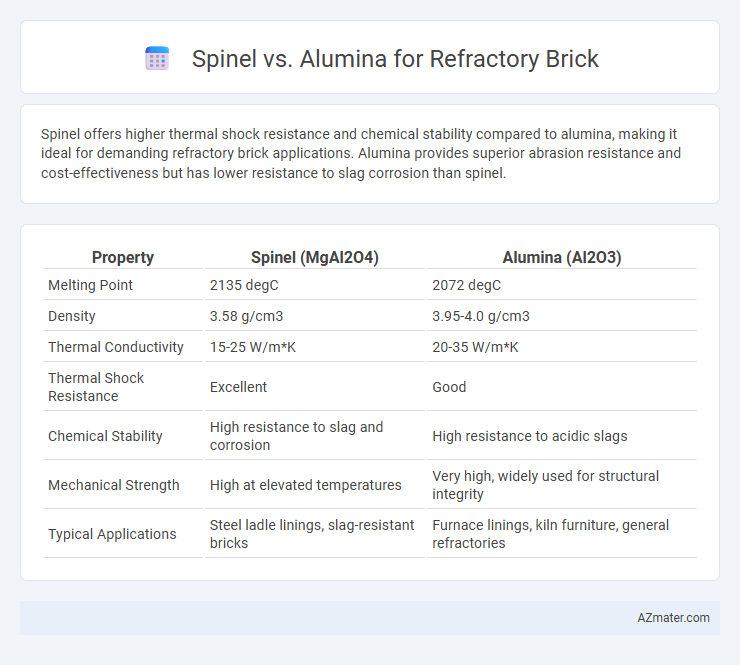Spinel offers higher thermal shock resistance and chemical stability compared to alumina, making it ideal for demanding refractory brick applications. Alumina provides superior abrasion resistance and cost-effectiveness but has lower resistance to slag corrosion than spinel.
Table of Comparison
| Property | Spinel (MgAl2O4) | Alumina (Al2O3) |
|---|---|---|
| Melting Point | 2135 degC | 2072 degC |
| Density | 3.58 g/cm3 | 3.95-4.0 g/cm3 |
| Thermal Conductivity | 15-25 W/m*K | 20-35 W/m*K |
| Thermal Shock Resistance | Excellent | Good |
| Chemical Stability | High resistance to slag and corrosion | High resistance to acidic slags |
| Mechanical Strength | High at elevated temperatures | Very high, widely used for structural integrity |
| Typical Applications | Steel ladle linings, slag-resistant bricks | Furnace linings, kiln furniture, general refractories |
Introduction to Refractory Bricks
Refractory bricks, essential for high-temperature industrial applications, rely on materials like Spinel and Alumina due to their exceptional thermal stability and resistance to corrosion. Spinel bricks offer superior slag resistance and thermal shock durability, while Alumina bricks provide higher alumina content, enhancing their strength and chemical inertness. Both materials are critical in environments such as steelmaking and cement production where reliable thermal performance and structural integrity are paramount.
Overview of Spinel in Refractories
Spinel, a magnesium aluminate compound (MgAl2O4), exhibits excellent thermal stability and resistance to slag corrosion, making it a preferred material in refractory brick applications. Its high melting point over 2135degC and compatibility with alumina enhance mechanical strength and longevity in high-temperature industrial environments. Spinel-alumina composites improve wear resistance and thermal shock resistance, essential for steelmaking and cement industries.
Alumina as a Refractory Material
Alumina is a highly effective refractory material known for its exceptional thermal stability, chemical resistance, and mechanical strength, making it ideal for high-temperature applications in furnaces and kilns. Compared to spinel, alumina bricks offer superior corrosion resistance against molten slags and maintain structural integrity under extreme heat, ensuring longer service life and reduced maintenance. The high melting point and excellent thermal conductivity of alumina contribute to efficient heat retention and energy savings in industrial processes.
Manufacturing Processes: Spinel vs Alumina Bricks
Spinel refractory bricks are manufactured by sintering or fusion processes that combine high-purity magnesia (MgO) and alumina (Al2O3) to form a stable spinel phase (MgAl2O4), enhancing thermal shock resistance and mechanical strength. Alumina bricks, produced primarily through sintering of high-grade bauxite or alumina powders, offer high chemical stability and excellent resistance to acidic slags at elevated temperatures. The manufacturing process differences impact their microstructure, with spinel bricks exhibiting a dense, interlocking crystal structure, while alumina bricks demonstrate high alumina content with uniform grains tailored for specific thermal and chemical environments.
Thermal Stability Comparison
Spinel refractory bricks demonstrate superior thermal stability over alumina bricks, maintaining structural integrity at temperatures exceeding 1750degC, whereas alumina bricks typically withstand up to 1650degC. The spinel phase (MgAl2O4) exhibits enhanced resistance to thermal shock and phase transformations, minimizing cracking and deformation under rapid temperature fluctuations. High thermal conductivity and chemical inertness further contribute to spinel bricks' extended service life in high-temperature industrial applications.
Chemical Resistance Analysis
Spinel refractory bricks exhibit superior chemical resistance compared to alumina bricks due to their stable spinel phase (MgAl2O4), which enhances resistance to slag and acidic gases in high-temperature environments. Alumina bricks, primarily composed of Al2O3, are more prone to corrosion from basic slags and alkali vapors, reducing their lifespan in aggressive chemical settings. The spinel structure's dense lattice improves durability and maintains integrity in molten slag interfaces, making spinel bricks ideal for applications requiring enhanced chemical resistance.
Mechanical Properties and Wear Resistance
Spinel refractory bricks exhibit superior mechanical strength and thermal shock resistance due to their dense microstructure and strong spinel phase, outperforming alumina bricks in harsh high-temperature environments. Alumina bricks, while offering excellent hardness and abrasion resistance, tend to have lower fracture toughness compared to spinel, making them more susceptible to cracking under mechanical stress. The wear resistance of spinel bricks is enhanced by their improved slag corrosion resistance and structural integrity, resulting in longer service life in steelmaking furnaces compared to alumina-based refractories.
Cost and Availability Factors
Spinel refractory bricks, composed primarily of magnesium aluminate, generally exhibit higher material and production costs compared to alumina bricks due to their complex manufacturing requirements and raw material scarcity. Alumina bricks, abundant in bauxite and alumina sources, benefit from widespread availability and lower cost, making them more economically viable for large-scale applications. Cost efficiency and raw material accessibility often drive the selection of alumina bricks over spinel in industries prioritizing budget constraints without sacrificing moderate thermal resistance.
Industrial Applications: Spinel vs Alumina
Spinel refractory bricks offer superior thermal shock resistance and chemical stability, making them ideal for applications in steelmaking and cement kilns where high-temperature fluctuations occur. Alumina bricks, with higher alumina content, provide excellent corrosion resistance and mechanical strength, preferred in glass furnaces and petrochemical industries for slag resistance. Industrial choice between spinel and alumina bricks depends on factors like slag composition, operating temperature, and mechanical stress, with spinel favored for enhanced durability in aggressive environments.
Conclusion: Selecting the Optimal Refractory Brick
Spinel refractory bricks offer superior thermal shock resistance and chemical stability in high-temperature environments compared to alumina bricks, making them ideal for applications involving rapid temperature fluctuations. Alumina bricks, with higher alumina content, provide excellent corrosion resistance and mechanical strength in acidic or neutral slag conditions, optimizing cost-efficiency for less aggressive environments. Selecting the optimal refractory brick depends on operational temperature, slag chemistry, and mechanical stress, with spinel bricks preferred for demanding, high-impact settings and alumina bricks suited for stable, moderately corrosive applications.

Infographic: Spinel vs Alumina for Refractory Brick
 azmater.com
azmater.com